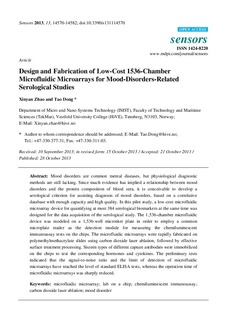| dc.contributor.author | Zhao, Xinyan | |
| dc.contributor.author | Dong, Tao | |
| dc.date.accessioned | 2017-12-19T14:15:13Z | |
| dc.date.available | 2017-12-19T14:15:13Z | |
| dc.date.created | 2014-01-10T14:09:33Z | |
| dc.date.issued | 2013 | |
| dc.identifier.citation | Sensors. 2013, 13 (11), 14570-14582. | nb_NO |
| dc.identifier.issn | 1424-8220 | |
| dc.identifier.uri | http://hdl.handle.net/11250/2473026 | |
| dc.description.abstract | Mood disorders are common mental diseases, but physiological diagnostic methods are still lacking. Since much evidence has implied a relationship between mood disorders and the protein composition of blood sera, it is conceivable to develop a serological criterion for assisting diagnosis of mood disorders, based on a correlative database with enough capacity and high quality. In this pilot study, a low-cost microfluidic microarray device for quantifying at most 384 serological biomarkers at the same time was designed for the data acquisition of the serological study. The 1,536-chamber microfluidic device was modeled on a 1,536-well microtiter plate in order to employ a common microplate reader as the detection module for measuring the chemiluminescent immunoassay tests on the chips. The microfluidic microarrays were rapidly fabricated on polymethylmethacrylate slides using carbon dioxide laser ablation, followed by effective surface treatment processing. Sixteen types of different capture antibodies were immobilized on the chips to test the corresponding hormones and cytokines. The preliminary tests indicated that the signal-to-noise ratio and the limit of detection of microfluidic microarrays have reached the level of standard ELISA tests, whereas the operation time of microfluidic microarrays was sharply reduced. | nb_NO |
| dc.language.iso | eng | nb_NO |
| dc.relation.uri | http://www.mdpi.com/1424-8220/13/11/14570 | |
| dc.rights | Navngivelse 3.0 Internasjonal | * |
| dc.rights.uri | http://creativecommons.org/licenses/by/3.0/deed.no | * |
| dc.title | Design and fabrication of low-cost 1536-chamber microfluidic microarrays for mood-disorders-related serological studies | nb_NO |
| dc.type | Journal article | nb_NO |
| dc.type | Peer reviewed | nb_NO |
| dc.description.version | publishedVersion | nb_NO |
| dc.rights.holder | © 2013 by the authors; licensee MDPI, Basel, Switzerland. This article is an open access article distributed under the terms and conditions of the Creative Commons Attribution license (http://creativecommons.org/licenses/by/3.0/). | nb_NO |
| dc.source.pagenumber | 14570-14582 | nb_NO |
| dc.source.volume | 13 | nb_NO |
| dc.source.journal | Sensors | nb_NO |
| dc.source.issue | 11 | nb_NO |
| dc.identifier.doi | 10.3390/s131114570 | |
| dc.identifier.cristin | 1087626 | |
| dc.relation.project | Norges forskningsråd: 197411 | nb_NO |
| dc.relation.project | Andre: Oslofjorfondet 220635 | nb_NO |
| dc.relation.project | Andre: Oslofjorfondet 229857 | nb_NO |
| cristin.unitcode | 222,58,4,0 | |
| cristin.unitname | Institutt for mikrosystemer | |
| cristin.ispublished | true | |
| cristin.fulltext | original | |
| cristin.qualitycode | 1 | |

